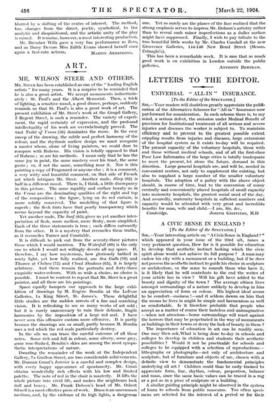ART.
MR. WILSON STEER AND OTHERS.
Mn. STEER has been established as one of the " leading English artists " for many years. It is a surprise to be reminded that he is also a great artist. We accept monuments indiscrimin- ately : St. Paul's and the Albert Memorial. Then, a trick of lighting, a sensitive mood, a good dinner, perhaps, suddenly reminds us that St. Paul's is also a great work of art. The present exhibition of Mr. Steer's work at the Goupil Gallery, 5 Regent Street, is such a reminder. The variety of experi- ment, the rapid certainty of expression, and the profound intellectuality of his work are overwhelmingly proved. The vast Toilet of Venus (56) dominates the room. In the easy sweep of the drawing, the subtle and perfect harmony of the colour, and the rhythmic surface design we must recognize a master whom, alone of living painters, we could dare to compare with Rubens. His vision is totally opposed to that of Rubens ; so are his methods. I mean only that he has the same joy in paint, the same mastery over his trust, the same gusto ; or, if not the same, something near it. Nor is this painting a copy of Fragonard or anyone else ; it is a comment, a very witty and beautiful comment, on that side of French art which intrigues Mr. Steer. Another nude, Sleep (62) is half in a different mood. There is, I think, a little discrepancy in this picture. The same rapidity and surface beauty as in the Venus are the dominating qualities of the right and top of the composition ; the figure, lying on its red curtain, is more solidly conceived. The modelling of that figure is superb ; the flesh tints have that pearly transparency which seems beyond the capacity of paint.
Yet another nude, The Surf (65), gives us yet another inter- pretation of flesh, more mellow, more fleshy, more simplified. Each of the three statements is true ; each differs outwardly from the other. It is a mystery that reconciles these truths, as it reconciles Turner and Constable.
It is difficult to pick out from the seventy-three pictures those which I would mention. The Waterfall (60) is the only one to which I would not willingly devote all my space. If, therefore, I say how mysterious, how gloriously bathed in misty light, yet how fully realized, are Sea Gulls (70) and Thames at Chelsea (72) and Cloud Shadows (65), it is largely arbitrary. And there remain the portraits and forty-three exquisite water-colours. With so wide a choice, no choice is possible. I must be content to repeat that Mr. Steer is a great painter, and all these are his paintings.
Space equally hampers our approach to the large exhi- bition of drawings by M. Eugene Bondin at the Lefevre Galleries, IA King Street, St. James's. These delightful little studies are the sudden arrests of a fine and searching vision. It is refreshing to see so many works of art sold ; but it is surely unnecessary to ruin their delicate, fragile harmonies by the imposition of a large red seal. I have never seen this offensive custom more offensive. It is partly because the drawings are so small, partly because M. Bondin uses a red which the red seals particularly destroy.
In the oils we can trace the careful outcome of all these notes. Some rich and full in colour, some silvery, some grey, some rose-flushed, Bondin's skies are among the most sympa- thetic interpretations of nature.
Dwarfing the remainder of the work at the Independent Gallery, 7A Grafton Street, are two considerable achievements. Mr. Duncan Grant's Interior is a careful and complex design, with every happy appearance of spontaneity. Mr. Grant obtains wonderfully rich effects with his low and limited palette. The note of red in the chair is masterly. It lifts the whole picture into vivid life, and makes the neighbours look dull and heavy. Mr. Frank Dobson's head of Mr. Osbert Sitwell is a most effective piece of work. Brass is an uncommon medium, and, by the violence of its high lights; a dangerous one. Yet so surely arc the planes of the face realized that the strong emphasis serves to impress Mr. Dobson's artistry rather than to reveal such minor imperfections as a duller surface might have suppressed. Finally, I wish to pay tribute to the two beautiful little works by Mr. Charles Cundall at the new Grosvenor Galleries, 144-146 New Bond Street (Messrs. Colnaghi's).
This has been a remarkable week. It is rare that so much good work is on exhibition in London outside the public galleries.
ANTHONY BERTRAM.














































 Previous page
Previous page